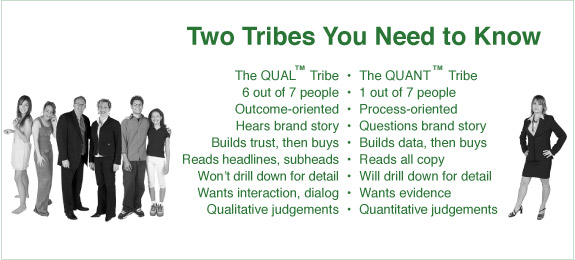The Quals and the Quants: Two Tribes You Need to Know

Because the Quals are more numerous, roughly six people out of seven, we’re tempted to call them “normal,” but that would be misleading and short-sighted. The other one-seventh of the population are “normal” in their own way, and an important audience, albeit one requiring different or additional messaging. (One-seventh of America is more than 40 million people. One-seventh of the world is a billion.)
The Quals, qualitative in their orientation, will listen to your brand story. They evaluate your messaging to verify and authenticate you, to see how you fit with their expectations. Do you look trustworthy? Do you provoke interest? Are you credible? Is what you say relevant?
The Quants, roughly one person out of every seven, share many of those characteristics, but they are not satisfied with that level of brand promise. They want to quantify and measure the proof statements that support your brand narrative. They approach your headlines and taglines with a greater degree of skepticism.
Let’s contrast the behavior of the two tribes in three purchase-decision situations: buying financial services, switching breakfast cereals, making an online purchase of a backpack for school use.

First, financial services. Buying life insurance or opening an account at a stock brokerage will always be made through a Trusted Financial Advisor (TFA). Even opening a simple checking account is not decided lightly – if the bank brand is trusted, it becomes the TFA. Often, a life-changing event precipitates financial purchase decisions: parents buy life insurance when baby is born. Banking relationships change after both a change of address and an unsatisfactory prior relationship. Stockbrokers screw up, and may be discarded. Financial relationships tend to be “sticky,” lasting sometimes for decades, so it takes a meaningful event to make it worthwhile to bother changing.
So here are Quals buying financial services: the TFA listens to the Qual-client, makes sympathetic noises, then presents a life insurance policy from a little-known company (or a checking account with 12 features, or a brokerage account with annual automatic portfolio balancing). The Qual looks her in the eye and asks, “Is this a good insurance carrier/Does this have the account features I need/is annual re-balancing often enough?” The TFA nods wisely, says yes, and the client signs. Case closed.
By contrast, Quants buying financial services: After the policy/account/whatever is presented, the Quant wants to know the company’s track record, the A.M. Best rating, the fees connected with the rebalancing, and more, and more. Trust is a beginning with this tribe, but it’s not enough.
 Switching cereals: Rolling through the supermarket, both a Qual and a Quant feel a little guilty about what the scale said this morning, and blame their Sugar Frosted ChocoBomb addiction. It’s like an impulse purchase, but not altogether spontaneous: these feelings have been accumulating, and both shoppers are willing to switch. Both shoppers pass by the ChocoBombs, and spot the package of Fiberific Flakes. It’s attractive, talks about being healthy (No trans fats! Contains Selenium!) and they both pluck it off the shelf.
Switching cereals: Rolling through the supermarket, both a Qual and a Quant feel a little guilty about what the scale said this morning, and blame their Sugar Frosted ChocoBomb addiction. It’s like an impulse purchase, but not altogether spontaneous: these feelings have been accumulating, and both shoppers are willing to switch. Both shoppers pass by the ChocoBombs, and spot the package of Fiberific Flakes. It’s attractive, talks about being healthy (No trans fats! Contains Selenium!) and they both pluck it off the shelf.
And then? The Qual drops it in the cart. The Quant stops cold, reads the nutrition chart on the back, then picks up a box of VitaBlaster NatuGlobs, to compare sodium content. Three full minutes later, she makes a choice and moves on.
Buying a backpack online: Both arrive at your website with expectations, looking for a backpack that matches their needs. If they arrived in response to your email or ad, online or off, they’ll have defenses up, waiting for the sales pitch. If they arrived via search engine, the defenses will be lower – because they found you, and it’s their idea. The page they land on has 4.5 seconds to demonstrate that it indeed has backpacks, with an attractive picture and some descriptive detail, including price.
For some Quals, this is enough. If it meets their needs, and seems reasonably priced, they may put it in the shopping cart immediately. For Quants, this is only the beginning. They’ll study product detail, think about dimensions, check out similar products, compare shipping costs. It may take them another visit, after a detour to competitors’ sites or even a brick and mortar store.
Okay? Chapter Two:
What are the Implications?
- Realize that these two tribes exist – but is there a big fat middle ground, with lots of people who have some traits of each? Of course there is, but that doesn’t obviate the need to be inclusive in your marketing, to make sure you reach the people on both pointy ends of the bell curve.
- Not everybody thinks the way you do:
- If you’re an extreme Quant, other people are not lazy and careless thinkers. They’re just wired differently.
- If you’re an extreme Qual, selling to Quants, give them more depth and detail than you’d need. They’re wired differently.
- Pictures, headlines and bullet points: since that’s as far as Quals will go, make sure your brochure(s) tell your brand story without heavy text.
- Consider an Executive Summary, followed by complete copy. Then, bury the complete copy.
- Advertising must have at least one little “rational” element to satisfy the Quants.
- On your website, minimize the text a reader sees first. Have one dominant picture, meaningful headlines, and white space. The page must be inviting to the eye, even for Quants who want lots of detail – remember, they will be willing to scroll down.
- Use keyword-rich text, even if it has to fall “below the fold,” farther down the page. People may read it; search engine robots will read it.
- Have drill-down pages for “more information.” 6/7ths will never get there, but Quants will often read them.
- Your brand must stand for one thing, to create credibility and impact. That’s the same, regardless of which tribe, or both, is your audience.
- Don’t get clinical. If you’re selling to bankers or scientists, the percentage of Quants will rise, but not as much as you think.
- Again. Let’s repeat that: many B2B marketers wrongly assume that their audience is exempt from the rules of attention and focus because they are unique, special, completely rational and anxious to hear 10-Reasons-Why-style detail, with as many benefits trotted out as space permits.
- A third time. Nobody is waiting to hear from you. Nobody will study your ad, regardless of tribe.
- A 10-reasons-why communication means you’re nine subtractions away from an idea.
- If you sell a service that involves a process, the Quants demand to know what the process is; the Quals want to know results.
- If you sell a product, the Quants want to know how to use it and what they get. The Quals want to know what they get.
- Everybody wants to know your brand story, and what emotional need you’ll fill – but the Quants want backup to prove it.
- These two tribes are present in every audience, so always allow for them.
- These are psychographic differences, not demographic.
- Even selling perfume, 1/7 of your audience will want to identify what exactly those floral notes are.
- Even selling printing presses, 6/7 of your audience wants to know what results to expect. 1/7 will study the schematics.
- Impulse purchases? People who are analytical and quantitative by nature (Quants) still make impulse purchases, but within the safety of known brands. E.g., she’ll buy a Snickers bar on impulse, but she won’t impulsively buy a candy brand she’s never had before.
- Considered purchases? There’s a popular myth that these buying decisions are rational. And yes, the sales cycle may be longer, and the information needs may be greater, it’s also true that emotions play a much larger role than people are comfortable admitting. We like to believe we’re always rational.
- Test yourself: are you a Qual or a Quant? Last time you bought a mutual fund (or leased a car, or obtained a loan) you were presented with a long, complicated contract to sign. Did you read it before signing? Six-sevenths of us did not.
- Puzzled about how to make sure you’ll reach both tribes effectively in your marketing? We think about this stuff all the time, and we’re willing to help. Call 312.836.0050.